11 Facts To Know About Coco López Cream Of Coconut
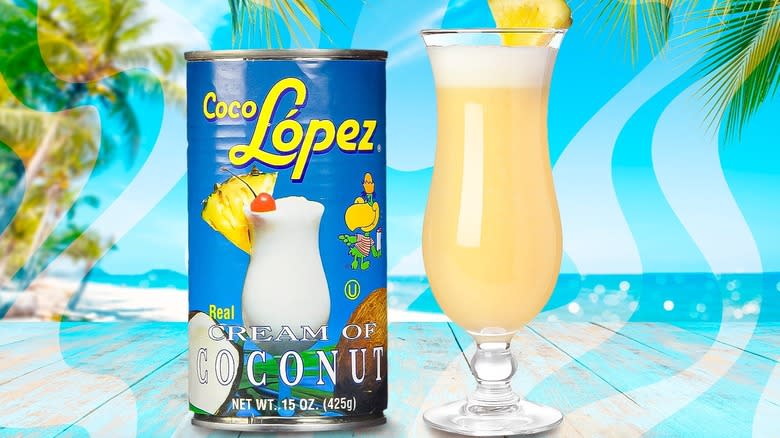
We may receive a commission on purchases made from links.
When you crack open a can of Coco López, it really does smell like the inside of a coconut. It's sweet but not too sweet, with a slightly nutty edge to the scent. Close your eyes and inhale, and you'll feel like you're on a beach in Puerto Rico, sun on your skin, sand between your toes, and a frosty piña colada sweating in your hand.
The beauty of Coco López is how you can create your own little version of paradise simply by picking up a can of the cream of coconut mixture at your nearest grocery store. What matters most, of course, is how Coco López tastes, and when used correctly, it's the ideal accompaniment to pineapple and rum. But much like the coconut it came from, a can of Coco López can be a tougher nut to crack than you'd expect.
A piña colada is indeed simple to make, but producing the Coco López used to give the cocktail its creamy, coconutty base has not been so simple. Creating Coco López cream of coconut is much more involved than cracking open a coconut and pouring the water into a can. It took a dedicated professor, money from his local Puerto Rican government, and thousands upon thousands of coconuts to turn the essential pantry staple into what it is today. Read on for more interesting facts about Coco López cream of coconut.
Read more: The 40 Absolute Best Cocktails That Feature Only 2 Ingredients
Coco López Was Created In A Laboratory
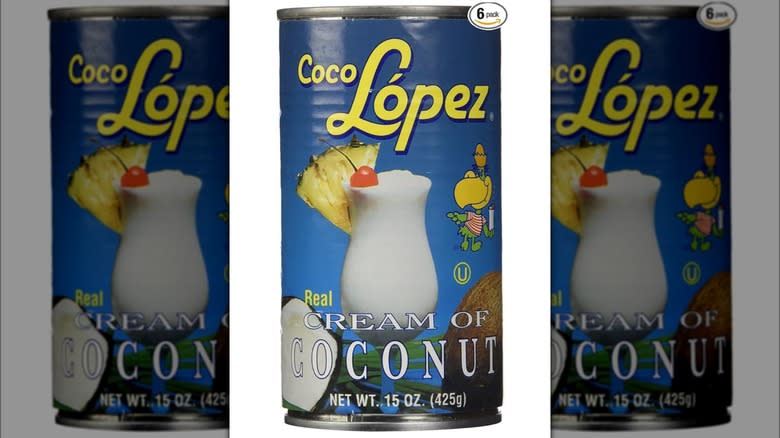
In a sea of coconut products, the Coco López can's bright-blue background makes it stand out in an overcrowded grocery aisle. The cute cartoon of a grinning bird holding a piña colada gives the product a lighthearted, vintage feel. And don't skip over the word "real"; from the beginning, Coco López was intent on providing a product that tasted like the inside of a coconut, not the inside of a metal can. Of course, the photo of a piña colada topped with a cherry and a pineapple slice tells you all you need to know: This product is instrumental in crafting an authentic and refreshing piña colada from the comfort of your own home. This may be what the man behind Coco López, Dom Ramon López Irizarry, had hoped people would glean from his product.
Irizarry first created the now-legendary cream of coconut product in a Puerto Rican laboratory in the late '40s. A professor of agricultural sciences, Irizarry was compelled by innovation. He was intent on revolutionizing the way cream could be created from coconut meat. If Irizarry's efforts were successful, then Puerto Rico could become the heart of coconut manufacturing and processing, and an established industry meant would bring countless new jobs. Inspired by this possibility, the local government gave Irizarry a grant to help him make this potential future a reality. The rest was history.
Coco López Was In The Original Piña Colada
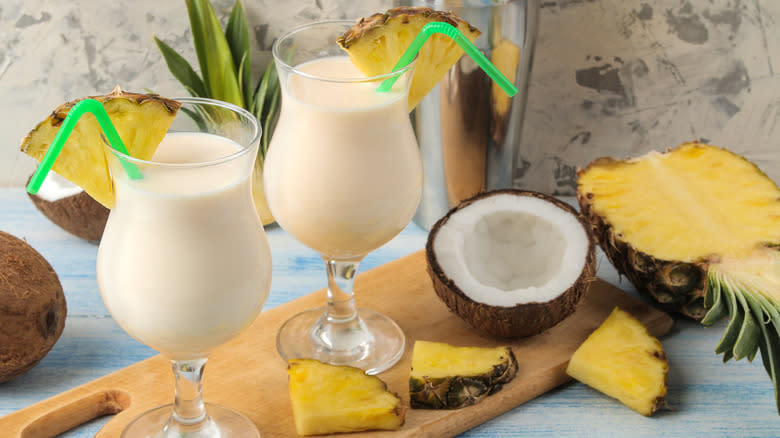
The piña colada is so ingrained in our collective cocktail-loving psyches that it's almost surprising to think that there was a time when it was the hot new drink on the scene. As one story goes, the Caribe Hilton hotel in San Juan was where the drink first gained popularity in the mid-'50s. The hotel was often crowded with guests, all clamoring for the refreshing drink at the bar. There's a chance that the piña colada as we know it today wasn't even an alcoholic drink back then.
Most piña colada-roads lead back to a man named Ramon "Monchito" Marrero, a hotel worker who combined vanilla ice cream with cream of coconut and pineapple juice ─ a milkshake, to be specific. In reality, no one knows for sure where the piña colada was actually created or by whom, but it's largely believed that Irizarry's delectable cream of coconut blend was one of the original ingredients. How else could the piña colada have achieved its distinctly sweet flavor and creamy consistency? Another point in favor of this cream of coconut being one of the original ingredients: As a Puerto Rican-born product, Coco López was readily available in San Juan, especially since it was still a relatively new creation in the '50s. The piña colada has since become Puerto Rico's official national drink, which must make Coco López one of Puerto Rico's most popular exports.
The Difference Between Cream Of Coconut And Coconut Cream
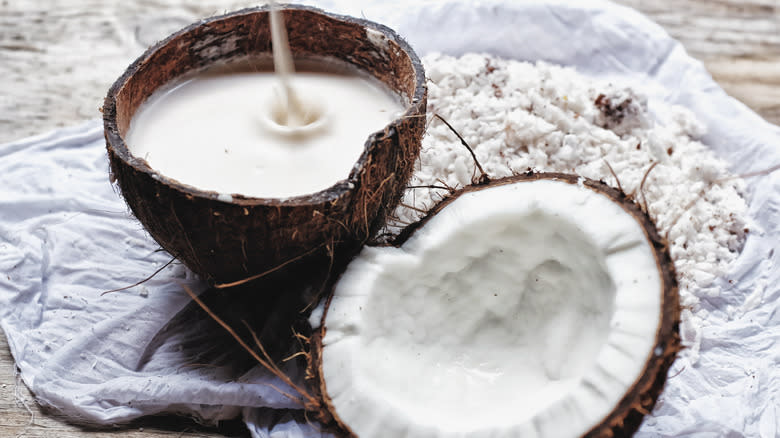
Cream of coconut and coconut cream ─ they must be the same thing, right? Wrong. In terms of flavor, consistency, and usage, the two ingredients couldn't be more different. This doesn't stop recipes from incorrectly using the two terms interchangeably, and where many cocktail recipes call for "coconut cream," what you really need is "cream of coconut." In order to explain the stark difference between cream of coconut and coconut cream, we need to introduce another product: coconut milk.
Coconut milk is created by soaking white coconut meat in hot water. Eventually, cream will rise to the top. At this point, a chef would normally skim off the cream. But when it comes to creating coconut cream and cream of coconut, this cream is obviously essential (sip your piña colada every time we say "cream"). If you were to collect the cream as is and put it in a jar, you'd have a jar of coconut cream. It's a useful ingredient thanks to its creamy consistency, and is especially great if you live the vegan lifestyle. Making cream of coconut, however, is a more arduous task. It's meant to be equal parts sugar and cream. Thanks to modern conveniences, you can buy Coco López instead of making it from scratch. Unlike coconut cream, cream of coconut is syrupy, and much sweeter to taste. That's why it works so well in cocktails and desserts.
Coco López Is Made Using A Specialized Cooking Process
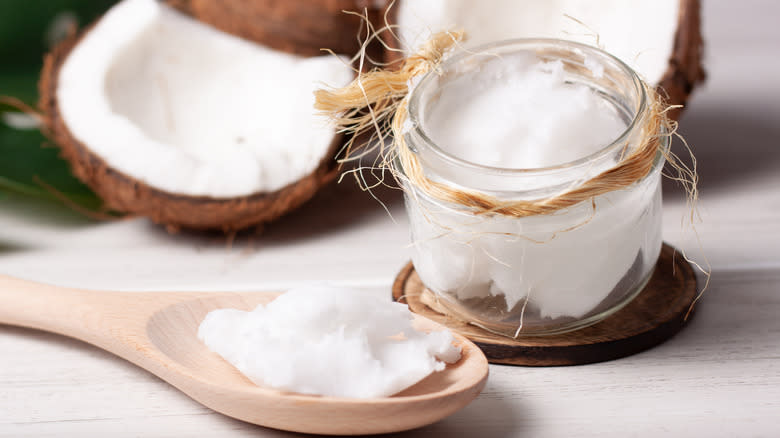
Irizarry was not the first person to extract cream from coconut meat, but he was one of the first people to commercialize it. Back when the piña colada was nothing more than a few coconuts and a dream, Irizarry was determined to find an easier, more delicious way of producing cream of coconut. His first move was to use only authentic Caribbean coconuts, which ensured fresh coconut meat. His second move was to think outside the box when it came to the water inside of a coconut. Coconut water and even coconut milk are usually too thin and light to add much flavor or texture to a cocktail, so Irizarry was determined to find a way to make coconut milk thicker. This is where his ingenious "new" ingredient came into play.
Sugar may not be a traditional thickening agent, but it can give a liquid a sweeter and creamier taste and texture. As proclaimed on the Coco López website, it was adding equal parts sugar to the coconut's cream that transformed the liquid into the piña colada base we know and love. "In his small laboratory, Don Ramon worked and developed Coco López, a delicious homogenized cream made from the tender meat of the coconut and blended with the exact proportion of natural sugar at the perfect combination of pressure and temperature resulting in a pure, smooth coconut cream."
Coco López Is An Excellent Dessert Ingredient

Just like the coconut it came from, cream of coconut is surprisingly versatile. But due to the high sugar content in Coco López, you have to be careful how you use it. Otherwise, you'll be left with a sickeningly sweet poke cake. When used sparingly, Coco López can add much-needed sweetness and a tropical coconut twist to your favorite desserts. You don't even need to stray far from the product's cocktail roots if you don't want to. Get creative by making piña colada cupcakes to combine two of the greatest things ─ alcohol and cake ─ into one scrumptious dessert. You obviously don't need to buy an entire coconut to make these cupcakes ─ that's what the Coco López is for ─ but you can buy one if you want to add fresh, authentic coconut flakes to the top of your cupcakes for an added island garnish.
For more inspiration, Coco López has a few dessert recipe ideas you can try, all of which are available on its site. There are expected dessert recipes ─ coconut creme pie, coconut lime pie, you get the idea ─ but then there are a few wild cards. A recipe for coconut citrus orange mousse, for instance, puts a bright, tangy spin on an otherwise straightforward dessert. Then there's coconut swirl coffee cake, a combination of sugar, spice, and coconut that sounds disjointed until you glimpse the moist vanilla cake and coffee/coconut crumbles.
Sweetened Condensed Milk And Coco López Can Be Substitued For Each Other
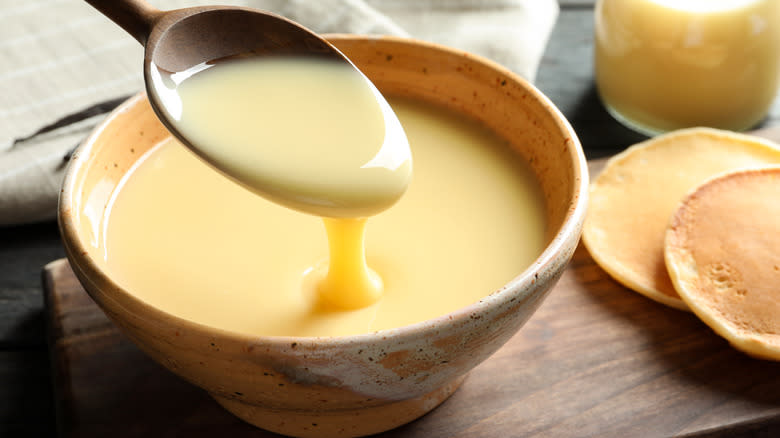
Since cream of coconut is not interchangeable with coconut cream, or with products of identical origins like coconut milk and coconut water, it can feel like it's one of a kind. While it's true that Coco López cream of coconut is a unique product, it doesn't mean you're out of luck if you don't have any lying around. There's another product that's part-milk and part-sugar: sweetened condensed milk. And much like Coco López, sweetened condensed milk helps to thicken and enrich the liquid it's added to. Both products are thinner than cream but thicker than milk, making them perfectly blendable and syrupy. There's one main pro to using sweetened condensed milk instead of Coco López: In most cases, a person is probably more likely to have sweetened condensed milk on hand than cream of coconut.
Of course, the main downside to using sweetened condensed milk is that the dish or drink will be lacking the cheerful coconut flavor that Coco López provides. Coco López isn't quite as sweet as condensed milk, either, which is important to keep in mind if you're thinking of substituting one for the other. And if you're wondering why on Earth you would ever want to swap a thick, luxurious can of condensed milk for Coco López, consider your gut. Those who have trouble digesting dairy can find a delicious, similarly textured alternative in Coco López.
Coco López Can Enhance Traditional Caribbean Meals
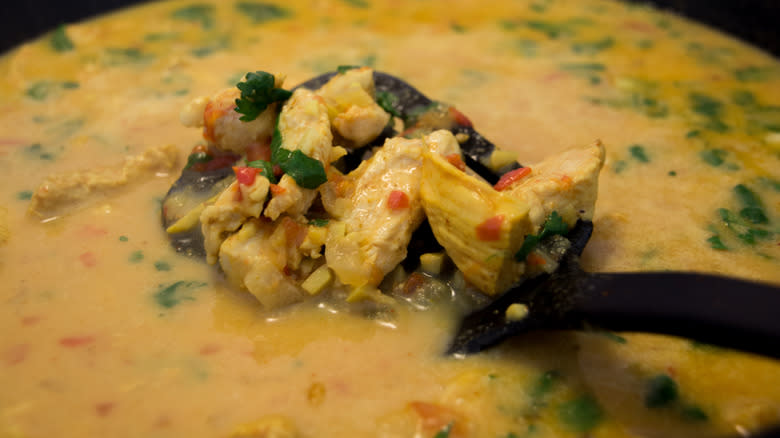
As versatile as Coco López can be, it's not a common essential in the wider gamut of savory dishes. Its syrupy consistency and high sugar content makes it a much better fit for drinks and desserts. Still, there are countless dishes ─ especially those that originated in the Caribbean ─ that depend on the humble coconut for a rich, sumptuous flavor. A couple of coconut-infused Puerto Rican dishes you have to try at least once include arroz con dulce, a rice dish that partly depends on coconut milk for its creamy texture and earthy flavor, and caldo santo, a fish stew with broth made from coconut milk and achiote oil. Coco López also recommends a few savory recipes in which its cream of coconut blend plays a major role.
On its website, the company's recipe for Caribbean shrimp kabobs suggests creating a delectable marinade made out of pineapple juice, oil, soy sauce, garlic, crushed red pepper, and, of course, Coco López cream of coconut. The mild coconut flavoring mixed with the heat of red pepper and tang of soy sauce wraps the shrimp in a happy summertime flavoring. In its chicken curry recipe, the onion, garlic, and curry powder are spicy foils to the calming coconut sweetness of Coco López. Cream of coconut can also be a satisfying ingredient in soups, sauces, glazes, and butters, such as in the brand's tangy coconut ham glaze and coconut barbecue sauce recipes.
70,000-85,000 Coconuts Are Processed By Coco López Every Day
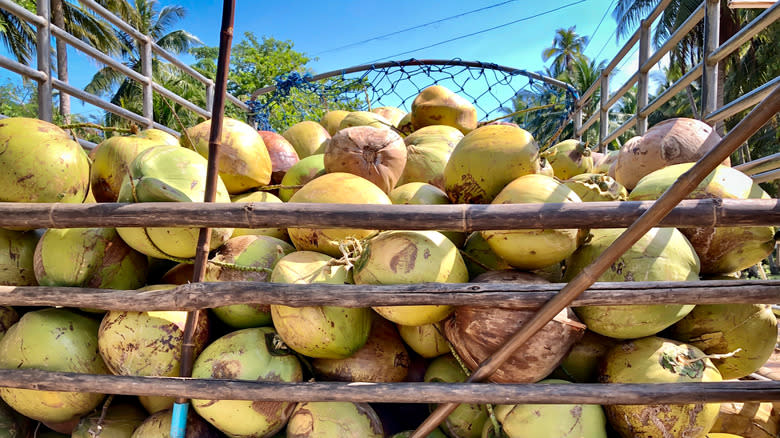
When Don Ramon López Irizarry first cracked through a hard coconut shell, he couldn't have known how many more coconuts he would eventually crack open. In the beginning, his small lab churned out approximately 20 cases of Coco López every day, with 300 coconuts being used in the process. The process of opening a coconut and extracting cream from its inner meat is not an easy one; when done by hand, it takes patience and elbow grease. Safely opening a coconut usually involves hitting it repeatedly in a specific spot with the spine of a large kitchen knife. Obviously, this method can be dangerous, not to mention slow. The fact that Coco López processed hundreds of coconuts in one day in the '50s is no mean feat.
And over the years, Coco López has only streamlined its process. The company eventually outgrew its small manufacturing plant and ended up merging with Industrias La Famosa, a beast in the canned goods manufacturing world. This merger allowed Coco López to spread its wings, and by 2018, the cream of coconut brand was processing 70,000 to 85,000 coconuts daily. This adds up to approximately 50 million coconuts every year, according to Coco López. With the piña colada's long-standing popularity in the U.S. and in Puerto Rico, Coco López can't process its hundreds of thousands of coconuts fast enough. Irizarry would be proud.
Coco López Cream Of Coconut Vs. Other Brands
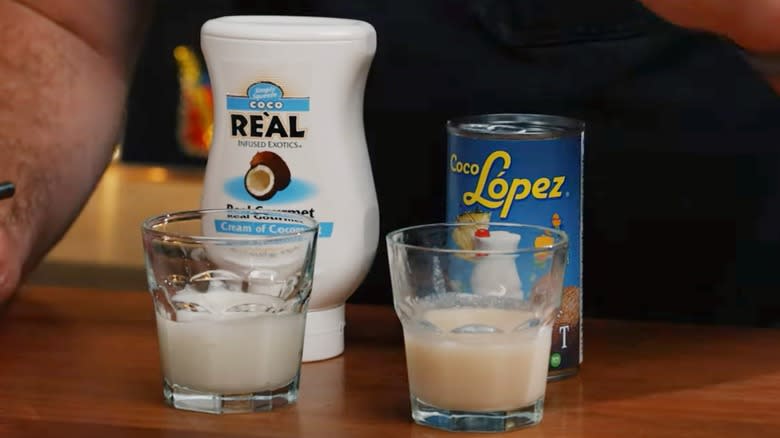
One of the more prominent versions of cream of coconut is from Goya. According to Goya's website, it's the "premier source for authentic Latino cuisine." Because of the brand's upstanding reputation and history dating back to 1936, it may be tempting to choose Goya's cream of coconut over Coco López. Like Coco López, Goya's version is made up of coconut milk and sugar, as well as various emulsifying agents. There's one major difference, however: Coco López comes directly from coconut meat, not coconut milk, which gives it a slightly thicker, creamier consistency.
Then there's Reàl, a brand of cream of coconut that comes in a user-friendly squeeze bottle. What Reàl lacks in comparable history, it makes up for in convenience. Unlike Goya and Coco López, Reàl's version doesn't run the risk of solidifying in a can because it comes in a squeeze bottle. And like Coco López, Reàl's cream is also made from coconut meat, not milk.
Coco López Has Expanded Into Other Coconut-Based Cooking Products
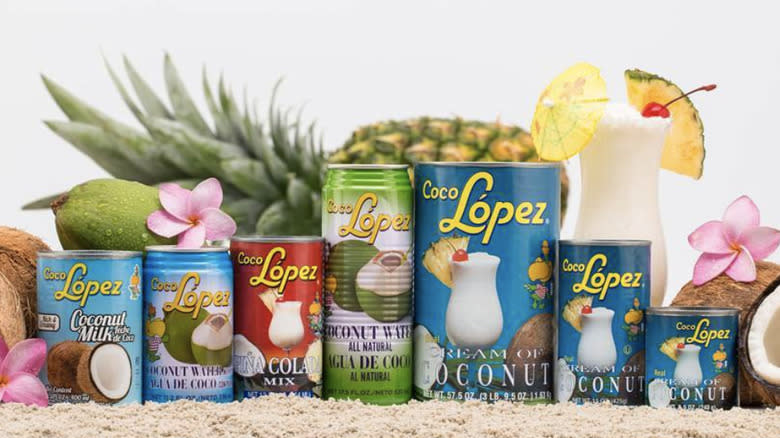
Coco López has expanded its expertise to other parts of the coconut, namely coconut milk and coconut water. As the company already uses the cream that forms on top of coconut milk, it's not surprising that it's aimed to perfect the actual milk part. This is significiant now more than ever considering how coconut milk is considered a pantry staple. As one of the best-tasting dairy alternatives on the market, coconut milk and Coco López feel like a match made in heaven.
The same can be said for Coco López's foray into coconut water, although finding bottles of the product online is harder than you think. Perhaps Coco López scaled back its production of coconut water in order to focus on its original cream of coconut, coconut milk, and its other product, piña colada mix. Coco López's piña colada mix contains cream of coconut and pineapple juice, and is highly rated by Amazon shoppers. "Tasty and easy to make in a blender," one reviewer wrote. They continued, "Ice, Coco Lopez pina colada, and rum! Can't go wrong (at least for me)." Given Coco López's historical connection to the drink. It's the closest most of us will get to an original piña colada served at the Caribe Hilton in 1958.
Coco López Can Be Used In Other Types Of Drinks
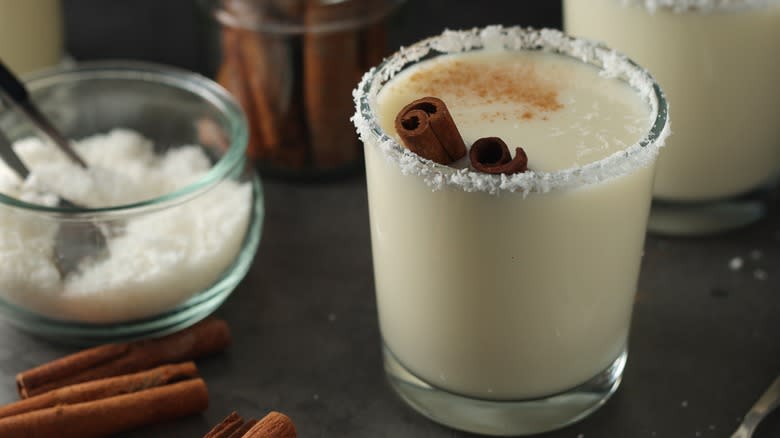
We all know a piña colada wouldn't be the same without Coco López, but if you're just not in love with the drink, then worry not: You can still put that can of Coco López to work at the bar. There are plenty of tropical, fruity, even Christmas-y drinks you can make with Coco López, including the cooling Caribbean Grasshopper (the green creme de menthe gives the drink its trademark green hue and minty flavor), and the protein-rich chocolate banana shake (Coco López gives the shake an additional nutty depth).
Of course, for more alcohol-rich options, we recommend this Caribbean Rum Cocktail recipe, which is basically paradise in a glass thanks to the tropical addition of Coco López. Also known as a Painkiller, this drink lives up to its name with its 2 ounces of dark rum and, of course, the intensely sweet cream of coconut. It's also one of the best ingredients for making tiki cocktails at home (just make sure that you shake the can as it tends to solidify when left alone), and can even be used in cozy winter drinks. For instance, you can easily add Coco López to booze-free eggnog or coquitos for a fun, tropical twist during the holidays.
Static Media owns and operates Tasting Table and Mashed.
Read the original article on Tasting Table.

